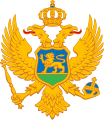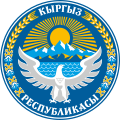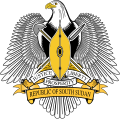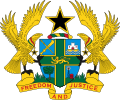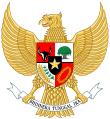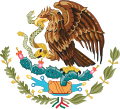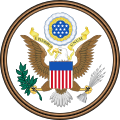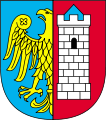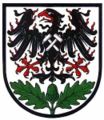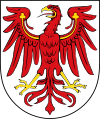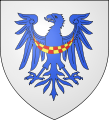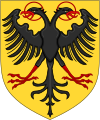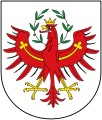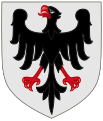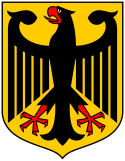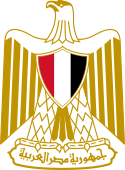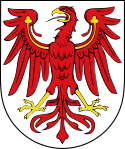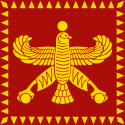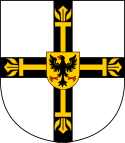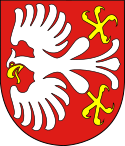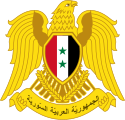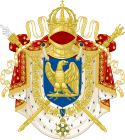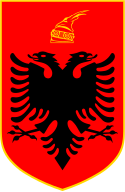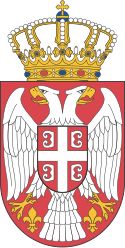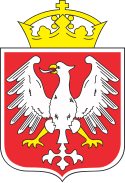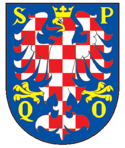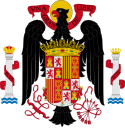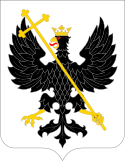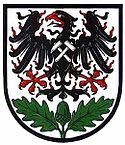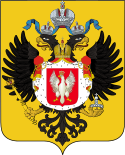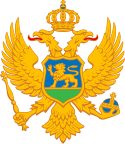Orzeł (symbol)
Orzeł – symbol państwowy popularny nie tylko w Europie, wykorzystywany w heraldyce w takich kompozycjach jako godło, trzymacze lub herb.
Historia
Orzeł jako symbol
Według niektórych uczonych, geneza orła jako symbolu sięga czasów wspólnoty praindoeuropejskiej, kiedy to orzeł jako symbol siły stał się atrybutem pierwszego z bogów praindoeuropejskiego panteonu – Diausa, znanego z późniejszej Grecji jako Zeus, a z Rzymu jako Jowisz, Iuppiter (archaicznie Diouis pater).
Symbolu orła używały jako swojego znaku (derafš) ludy irańskie. Złoty orzeł był godłem perskiej dynastii Achemenidów panującej na Bliskim Wschodzie od VI do IV wieku p.n.e. Po znak ten przejęli Seleucydzi i Partowie, a później też władcy Armenii[1]. Jako symbol występuje też w pismach religijnych – irańskiej Aweście (jako symbol boskiej chwały) oraz w Biblii (jako symbol mądrości Jahwe, np. w księdze Ezechiela oraz Apokalipsie)[1].
W religii rzymskiej orzeł był atrybutem i posłańcem Jowisza. Jako symbol siły tego boga stał się emblematem legionów rzymskich. Podobizna (figurka) orła z rozpostartymi skrzydłami widniała m.in. na szczycie sztandaru legionów – vexillum i labarum (do czasu zastąpienia przez symbol Chi Rho za cesarza Konstantyna Wielkiego).
W Cesarstwie Rzymskim orzeł stał się z czasem emblematem cesarza jako zwierzchnika armii, a następnie uniwersalnym symbolem państwa rzymskiego. Po przeniesieniu stolicy do Konstantynopola i utrwaleniu się dualistycznego charakteru cesarstwa (z podziałem na łaciński zachód oraz grecki wschód) rozpowszechniła się symbolika orła dwugłowego, gdzie dwie głowy symbolizują dwie stolice: lewa Rzym, prawa Konstantynopol.
We wczesnym średniowieczu orła używali również Goci, Gepidowie i Frankowie. Orzeł jednogłowy, nawiązujący do tradycji poprzedzającej rozpad cesarstwa rzymskiego na dwie części, stał się godłem Karola Wielkiego, a potem Świętego Cesarstwa Rzymskiego i innych państw, m.in. księstw śląskich. W XIV wieku stał się godłem Polski. Jako pierwszy władca Polski użył symbolu orła Przemysł II na pieczęci majestatycznej z 1295 roku[2].
Orzeł dwugłowy
Orzeł dwugłowy był znany już w głębokiej starożytności[3]. W mitologii rzymskiej orzeł dwugłowy nawiązuje do głowy Janusa – siła stwórcza, wszechwiedza[4]. Dwugłowy orzeł pozostał godłem Cesarstwa Bizantyńskiego, które nigdy nie wyrzekło się pretensji do panowania nad utraconą zachodnią częścią Cesarstwa Rzymskiego. Za panowania cesarza Zygmunta Luksemburskiego w roku 1410, aż do roku 1806 dwugłowy orzeł stał się widocznym godłem Świętego Cesarstwa Rzymskiego Narodu Niemieckiego.
Do heraldyki ruskiej trafił prawdopodobnie poprzez pierwszych wareskich władców Rusi – Rurykowiczów, którzy prowadzili ożywioną działalność handlową i religijną z Bizancjum i Konstantynopolem. W XIII w. lub wcześniej, pojawił się z sąsiadującej z Polską Rusią Halicką[5]. Dwadzieścia pięć lat po ślubie Iwana III z Zoe Paleolog (1497), dwugłowego orła uznano za oficjalny herb Wielkiego Księstwa Moskiewskiego. Od 1993, dwugłowy złoty orzeł z czasów Cesarstwa Wschodniorzymskiego jest ponownie herbem Rosji.
Galeria
Współczesne herby i godła państw
Herby miejscowości
Herb Sandomierza
Herb Lubina
Herb Czernihowa, Ukraina
Herb Brains, Francja
Herb Orła, Rosja
Herb Jesionika, Czechy
Herb Ołomuńca, Czechy
Herb Opawy, Czechy
Herb Polički, Czechy
Herb Stochova, Czechy
Herb Znojma, Czechy
Herby regionów
Herb Moraw, Czechy
Herb Brandenburgii, Niemcy
Herb Tyrolu Południowego (Górnej Adygi), Włochy
Herb prowincji Trydent, Włochy
Herb Burgenlandu, Austria
Herb Krainy, Słowenia
Herb Kraju Sudetów, Czechy
Herby i godła historyczne
Herb Polski przed 1927 r.
Herb Prus Królewskich
Herb Prus Książęcych
Herb Królestwa Prus
Godło Świętego Cesarstwa Rzymskiego, XIII-XIV w.
Herb Cesarstwa Austrii, XIX w.
Godło perskiej dynastii Achemenidów z czasów Cyrusa Wielkiego, VI w. p.n.e.
- (c) Goran tek-en, CC BY-SA 4.0
Godło Cesarstwa Bizantyńskiego w okresie Paleologów, XV w.
Herb Księstwa Moskiewskiego, XVI w.
Herb Imperium Rosyjskiego, XIX w.
Herb województwa czernihowskiego Rzeczypospolitej
Herb Hiszpanii za Królów Katolickich (1475-1504)
Herb frankistowskiej Hiszpanii (1939–1975)
Herb Tyrolu
Herb Królestwa Sycylii
Herb Okręgu Rzeszy Kraj Sudetów (1940–1945)
Symbole wojskowe
Aquila – rzymski orzeł wojskowy
Rekonstrukcja rzymskiego vexilium z orłem
Orzeł napoleoński
Polski orzeł wojskowy na tarczy Amazonek
Czapka oficera ułanów Królestwa Polskiego z orłem
Polski orzełek legionowy
Orzełek 1 Dywizji Piechoty
Współczesny polski sztandar wojskowy z orłem na płacie i głowicy
Przypisy
- ↑ a b Encyclopaedia Iranica, DERAFŠ, iranicaonline.org [dostęp 2021-12-30] (ang.).
- ↑ Stanisław Russocki, Godło, barwy i hymn Rzeczypospolitej. Zarys dziejów, Wiedza Powszechna, Warszawa 1978.
- ↑ Polskie herby ziemskie: geneza, treści, funkcje. 1993; „Dwugłowego orła po raz pierwszy użyli zamieszkujący Azję Mniejszą około roku 1800 p.n.e. Hetyci, twórcy potężnego państwa, które zagrażało nawet Egiptowi.” Stanisław Russocki, Zarys dziejów. 1978; „Symbol dwugłowego orła był znany w cywilizacji łacińskiej. W starożytnym Rzymie umieszczano go obok postaci bogów.”, [w:] Andrzej Andrusiewicz. Polska i jej wschodni sąsiedzi. 2009; „Dwugłowy orzeł z legendy ruskiej porywa dzika i składa na wzgórzu nad przyszłą Moskwą”. Władysław Kopaliński. Słownik symboli.
- ↑ Władysław Kopaliński. Słownik symboli. s. 287.
- ↑ Wyobrażenia dwugłowego orła na Rusi, na miniaturach przedstawiających Jarosława Mądrego, gdzie widnieje na jego płaszczu, podobnie jak i na płaszczu Jarosława, księcia Nowogrodu (1198), na dokumentach z czasów Jurija i Wsiewołoda (1220) oraz Daniły (1235)., [w:] Alexander Solovjev. Les emblemes heraldiques de Byzance et les Slaves. t. VII, 1953.
Media użyte na tej stronie
Uproszczony obraz godła Polski; oficjalne godło: Coat of arms of Poland-official.png
Coat of arms of Liechtenstein
Coat of arms of Austria: Coat of arms of Austria, depicting the black eagle. (Not official Version with several mistakes in colours, dimensions and other.)
Coat of arms of Romania.
Herb województwa dolnośląskiego (od 2009)
Autor: Лобачев Владимир. Base colors: File:Tapestry with the coats of arms of Poland (White Eagle) and Lithuania (Vytis, Pahonia) and a figure of Victory.jpg, Licencja: CC BY-SA 3.0
Rekonstrukcja herbu Rzeczypospolitej
Autor: Sodacan, Licencja: CC BY-SA 3.0
Imperial Coat of Arms of the Empire of Austria-Hungary, used from 1866 to 1915.
Orzełek legionowy
Orzeł tzw. wzór 43 (piastowski) noszony m.in. na czapkach przez żołnierzy 1 Dywizji Piechoty im. Tadeusza Kościuszki. Popularnie nazywany przez żołnierzy kuricą, kurą czy też wroną.
Autor: Sodacan, Licencja: CC BY-SA 3.0
Standard of Cyrus the Great, founder of the Persian Achaemenid Empire. Called the: Derafsh-e Shahbaz-e-Talayi or the Golden Falcon (Persian: درفش شاهباز طلایی).
- The standard is described by Xenophon of Athens in Cyropaedia (Book VII, C.1) as: "...and the word went down the lines, "Eyes on the standard and steady marching!". The standard was a golden eagle, with outspread wings, borne aloft on a long spear-shaft, and to this day such is the standard of the Persian king." (however here he is describing Artaxerxes II's standard at Cunaxa).
Autor: Heralder, Licencja: CC BY-SA 3.0
Coat of Arms of the Catholic Monarchs, (1492-1504)
Godło Polski z lat 1919 - 1927.
Emblem of Yemen. From http://www.brandsoftheworld.com/search/93446021/113560.html
Coat of Arms of the Hashemite Kingdom of Jordan during the reign of King Hussein. Inscription on the scroll comprises three phrases. On the right side is “Al Hussein bin Talal bin Aoun” (Aoun is the great grandfather of Al Sharif Al Hussein bin Ali); in the middle is “King of the Hashemite Kingdom of Jordan”; on the left side: “Who seeks support and guidance from God.”
Roman eagle (militar ensign of the ancient Roma), generally carried by an aquilifer.
Herb Prus Królewskich
Autor: Popik, Licencja: CC BY-SA 4.0
Herb mały Księstwa Warszawskiego (1807-1815)
Autor: BrokenSphere, Licencja: CC BY-SA 3.0
A French Imperial Eagle, probably from the 32nd regiment of infantry, on display at the Louvre des Antiquaires in Paris, France.
Autor: own work, Licencja: CC BY-SA 3.0
Tschapka of the officer of 3th Uhlan Regiment of Congress Poland
Autor: JakaśKreatywnaNazwa123, Licencja: CC BY-SA 4.0
Herb mały Wielkich Mistrzów Zakonu Krzyżackiego
Autor: Лобачев Владимир, Licencja: CC BY-SA 4.0
Герб Черниговского воеводства в составе Речи Посполитой. 1635 г. По гербовнику Каспера Несецкого. Издание 1839 года
Modern version of the historical arms of Moravia.
Ursprüngliches Wappen des Königreichs Preußen und der späteren Provinz Ostpreußen.
Autor: Tom Lemmens (in collaboration with Heralder), Licencja: CC BY-SA 3.0
Greater Coat of Arms of Joseph II, Holy Roman Emperor
Coat of arms of Iraq as adapted to new 2008 form of national flag -- standard pan-Arab "Eagle of Saladin" with shield of the tricolor of national flag (with the "Takbir" الله أكبر in Kufic text, as on the flag), holding a scroll with the words جمهورية العراق; (Jumhuriyat al-`Iraq "The Republic of Iraq").
Autor: Heralder & Tom Lemmens, Licencja: CC BY-SA 3.0
Shield and Coat of Arms of the Holy Roman Emperor, based on the depiction in Codex Manesse (c. 1310). An imperial coat of arms in this style was in use from c. 1200 to c. 1430. From 1433 (accession of Sigismund), use of the double-headed eagle became prevalent. The shield shape used here is typical of the early to mid 14th century. A variant with a shield shape more typical of the late 14th to early 15th century can be found here.
SVG version of the South Sudan Coat of Arms, drawn from the low-res png version available at this time.
Autor: Tom Lemmens & Heralder, Licencja: CC BY-SA 3.0
Double-headed Reichsadler, Heraldic shield of the Holy Roman Emperor, from Wernigeroder Wappenbuch (c. 1475-1500) [the heads should be crowned]
Coats of arms of Třinec, Czechia
Autor: Heralder, Licencja: CC BY-SA 3.0
Arms of Manfred, king of Sicily
Coat of arms of Burgenland
V modrém štítě vpravo hledící zlato-červeně šachovaná korunovaná orlice se zlatou zbrojí nesoucí na hrudi modrý štítek se zlatým majuskulním písmenem Z a provázená po stranách šesti (3,3) zlatými liliemi.
Coat of Arms of Russia in mid-16th centyry
Autor: Glasshouse, Licencja: CC BY-SA 4.0
Shield of the Prussian State of Brandenburg
State emblem of Indonesia is called Garuda Pancasila. The main part of the coat of arms is the golden mythical bird Garuda with a shield on its chest and a scroll gripped by its leg bears the national motto: "Bhinneka Tunggal Ika", roughly means "Unity in Diversity". The shield's five emblems represent Pancasila, the five principles of Indonesia's national philosophy. The numbers of feathers was meant to symbolize the date of Indonesian Proclamation of Independence; 17 feathers on each wings, 8 tail feathers, 19 upper tail feathers (under the shield, above the tail), and 45 neck feathers; all symbolize 17-8-1945; 17th August 1945. Garuda Pancasila was designed by Sultan Hamid II of Pontianak, and was adopted as national coat of arms on February 11, 1950.
Coat of Arms of the Republic of Ghana, adopted on 4 March 1957
Autor: Sodacan, Licencja: CC BY-SA 3.0
Imperial Coat of Arms of the French First Empire (1804-1815), under Napoleon Bonaparte.
- The Arms depicts a shield with a golden eagle in front of a blue background, within its talons clutching a thunderbolt. The shield is surrounded by Napoleon's red Imperial mantle, filled with golden bees. The shield is topped by a the Imperial crown, which sits atop a golden Imperial helmet. Surrounding the shield is the the chain and pendant of the Legion d'honneur. Crossed behind the shield are the Scepters of justice and mercy.
- Charles Normand, Armes et sceau de l'Empire français, Paris, 1804
Mały herb Serbii
Autor: Starfilar
Tschechische Länder, Licencja: CC BY-SA 4.0
Znak Sudetoněmeckého krajanského sdružení
Autor: SanchoPanzaXXI, Licencja: CC BY-SA 4.0
Escudo de España según decreto de 11 de octubre de 1945. Estuvo en vigor hasta 1977. Luis Miguel Arias, Santiago Dotor, Historical Flags 1939-1945 (Spain)
The Imperial Eagle or Emblem of the German Empire (German Reich, used 1935–1945), which features an eagle looking over its right shoulder, that is, looking to the left from the viewer's point of view. It is similar to the Parteiadler or Emblem of the Nationalsozialistische Deutsche Arbeiterpartei (NSDAP; known in English as the National Socialist German Workers' Party, or simply the Nazi Party), but the eagle of the latter is looking over its left shoulder, that is, looking to the right from the viewer's point of view.
The State Emblem of the Kyrgyz Republic.
(c) Alex Tora, CC BY-SA 3.0
Coat of arms of the Polish-Lithuanian Commonwealth.
Autor: Ta ^specifik^ z W3C grafika wektorowa została stworzona za pomocą Inkscape przez Avalokitesvara ., Licencja: CC BY-SA 3.0
Uwaga! Jest to współczesna rekonstrukcja średniego herbu Królestwa Kongresowego
Coat of Arms of the German "Reichsgau Sudetenland", 9.9.1940-1945
Autor: Ssolbergj, Licencja: CC BY 3.0
Vexillum of the Roman Empire.
Coat of arms of the Republic of Montenegro (adopted on 13 July 2004)
Autor: Elżbieta Kossecka, Licencja: CC BY-SA 4.0
Orzełek na czapkę II RP. Pamiątka po gen. bryg. Stefanie Kosseckim
Imperial Eagle of the German Empire from 1889 to 1918.
Autor: Ta ^specifik^ z W3C grafika wektorowa została stworzona za pomocą Inkscape ., Licencja: CC BY-SA 4.0
Sztandar 4 Brygady Kawalerii Pancernej - strona prawa
(c) Goran tek-en, CC BY-SA 4.0
The Byzantine double-headed eagle with the sympilema (the family cypher) of the Palaiologos dynasty.









